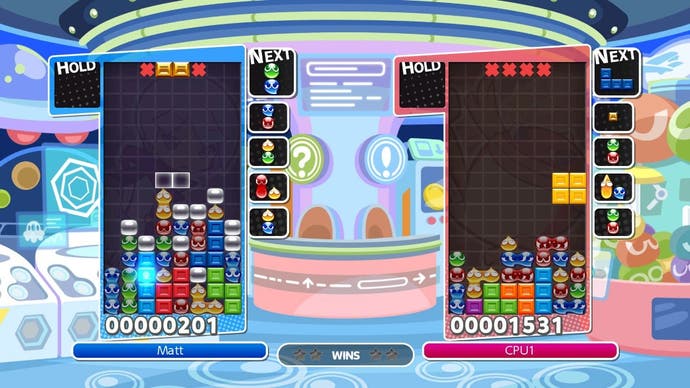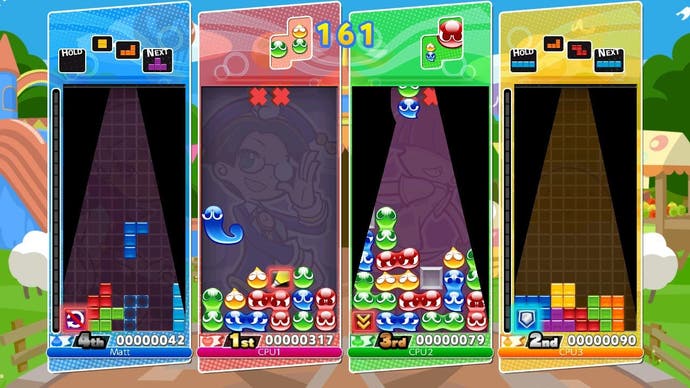Puyo Puyo Tetris review
Block party.
If my mum can recognise a game of Tetris by its ear-worm-for-the-ages Type A music, it's probably not a series that needs much introduction. Puyo Puyo, on the other hand, might be. Even now, 26 years after its initial release, Puyo Puyo has largely been ignored outside of Japan despite being bloody brilliant.
Puyo's history in the west is mostly one of makeovers (it's still probably best known here under its re-skinned 1993 Mega Drive guise, Dr. Robotnik's Mean Bean Machine), failed marketing pushes (the series enjoyed brief success as Puyo Pop in the early 2000s), and the occasional mini-game cameo, such as the one currently gracing 3DS game Hatsune Miku: Project Mirai DX. Meanwhile, Japan has seen over 20 Puyo Puyo games and spin-offs since the series' 1991 debut.
Puyo Puyo's continued obscurity over here is a little baffling, given that it's one of the best falling-block-style puzzle games around. Slotting firmly into the block-matching puzzle subgenre, your job in Puyo Puyo is to remove blobs (or "puyos" if you will) from the board by gathering them into groups of four or more matching colours. It looks innocuous enough, given its cheery veneer, but Puyo Puyo is a considerably tougher game to master than Tetris; while Tetris is a game of speed and precision, Puyo Puyo is the more considered, tactical experience, emphasising pattern placement and forward planning.

The draw of Puyo Puyo Tetris, then, is that you're getting two superb puzzle games in one package, and developer Sonic Team's lively mash-up is a real treat. Key to its success is the fact that both games complement each other brilliantly when played in tandem; Tetris' frenetic, high-speed rhythm provides a beautiful counterpoint to Puyo Puyo's more strategic edge, and the game gets a lot of mileage from exploiting and experimenting with its dual core.
Interestingly however, it's only in Puyo Puyo Tetris' 'Fusion' mode that both series properly intermingle. Here, each game's distinct mechanisms are blended into one, and the result is a fascinating, if chaotic and technically demanding, novelty. For the most part though, both series remain separate and, depending on your chosen mode, you'll either play one, the other, or alternate between the two.
Puyo Puyo has always skewed heavily toward competitive play, and that's true for this latest incarnation too. There's plenty for you to do as a solo player, but outside of the occasional challenge in 'Story' mode and the pure endless variants of each game, you won't often be puzzling in isolation. Instead, you'll spend most of your time battling against other players, be they AI-driven or human. Online play is rewarding but brutal, and the game's AI pulls no punches either, meaning that Puyo Puyo Tetris might not suit those hoping for a more relaxed challenge.
The bulk of play is a far cry from the gentle, meditative tension of solo Tetris, which is likely to be most people's point of reference here; instead, Puyo Puyo Tetris is a game of fraught, aggressive competition, sometimes wearingly so. Battles are consistently thrilling but hard won, and it's pretty much compulsory that you take the time to learn the nuances and advanced tactical intricacies of each game. This won't be news to anyone that's dabbled with multiplayer Tetris and Puyo Puyo before, but newcomers might be surprised at just how high the bar to entry is in competitive play.

Victory against an accomplished opponent (basically everyone online right now) is dependant on engineering as many combos and chains as possible; the more you string together, the more useless 'rubbish' pieces will be spewed out onto your opponent's board. Combos and chains, in turn, are dependant on the effective deployment of advanced moves like T-spins in Tetris (essentially, clearing lines by rotating pieces into awkward gaps), and column stacking in Puyo Puyo. They're not easy techniques to master, although enormously satisfying when you do, but the game does a good job of introducing, then hammering home, advanced play.
There are a couple of basic walkthroughs to get you started (and some excellent online tutorials), but the most invaluable lessons come from the game's carefully paced single-player 'Story' mode, which serves as an entertaining, extended introduction to the world of Tetris and Puyo Puyo. There are around 100 challenges here, ranging from competitive face-offs to solo time attacks, and each one gradually brings new tactical complications into play; no challenge lasts longer than a few minutes, but later objectives are designed to effectively stop you in your tracks if you don't get those advanced techniques down pat.
This tough heart is hidden under a sugary surface; the entire package is delivered with Sonic Team's usual breezy hyper-enthusiasm, all bright colours, bold lines and upbeat tunes. 'Story' mode, for instance, bookends its challenges with semi-animated, fully-voiced cut-scenes. It's incredibly slick, and often amusing, bringing back dozens of familiar faces from the Puyo Puyo series, but the irrepressible wall-to-wall whimsy will either delight or rapidly exhaust, depending on your constitution.
Nowhere is Puyo Puyo Tetris' lavish attention to detail more more evident though than in its multitude of carefully considered, consistently enjoyable game variants, all playable solo (with AI opponents), locally or online with up to four players. For those interested in pure technical play, 'Versus' mode lets opponents mix and match game types before facing-off, while 'Swap' mode demands real mastery of both games, continually switching back and forth between the two.
Puyo Puyo Tetris also proves its worth as a party game, offering a surprisingly raucous, combative multiplayer experience. 'Party' mode is pure chaos, hilariously subverting Puyo Puyo Tetris' precise puzzling by constantly tossing in wildly unfair power-ups, turning the screen black, for instance, or rapidly increasing drop rates. 'Big Bang', meanwhile, is a brilliantly compulsive game of rapid-fire elimination. Here, you simply need to score the most points by clearing the board as quickly and as often as possible; it's absolute mayhem and the elimination at the end of each round is proper edge-of-your-seat stuff.
Customisation is another strength of Puyo Puyo Tetris if you're not entirely happy with the way a particular mode plays; every permutation of every mode can be tweaked to suit your exacting whims, and it's even possible to purchase new tile skins and voice packs with the credits you earn during play. It's a little disappointing that you can't switch to the original Japanese voices, but the English dub is strong and tonally perfect, ably matched by the lively script.
It's worth noting just how well suited Puyo Puyo Tetris is to Switch too. It's a hoot on PS4 of course, but the flexibility of Nintendo's new platform really brings out the best in the game. It's a cracking solo experience on the go, with a quick, compulsive hook that's well suited to portable play, and the Switch's inherent social gaming design (with its plop-anywhere screen and instant dual controller setup) is a perfect match for Puyo Puyo Tetris' competitive focus.
Sonic Team has crafted a superb puzzler in Puyo Puyo Tetris, deftly combining two distinct genre classics into one seamless, generously entertaining whole. The fierceness of its competitive, strategic play can come as a surprise though, and you will need to learn the game's tactical intricacies to get the most from of it outside of party play. Once you're over the hump though, Puyo Puyo Tetris is a blast: exhilarating, exhausting, infuriating, and empowering all in one go. And if it doesn't finally put Puyo Puyo on the map over here, nothing will.



